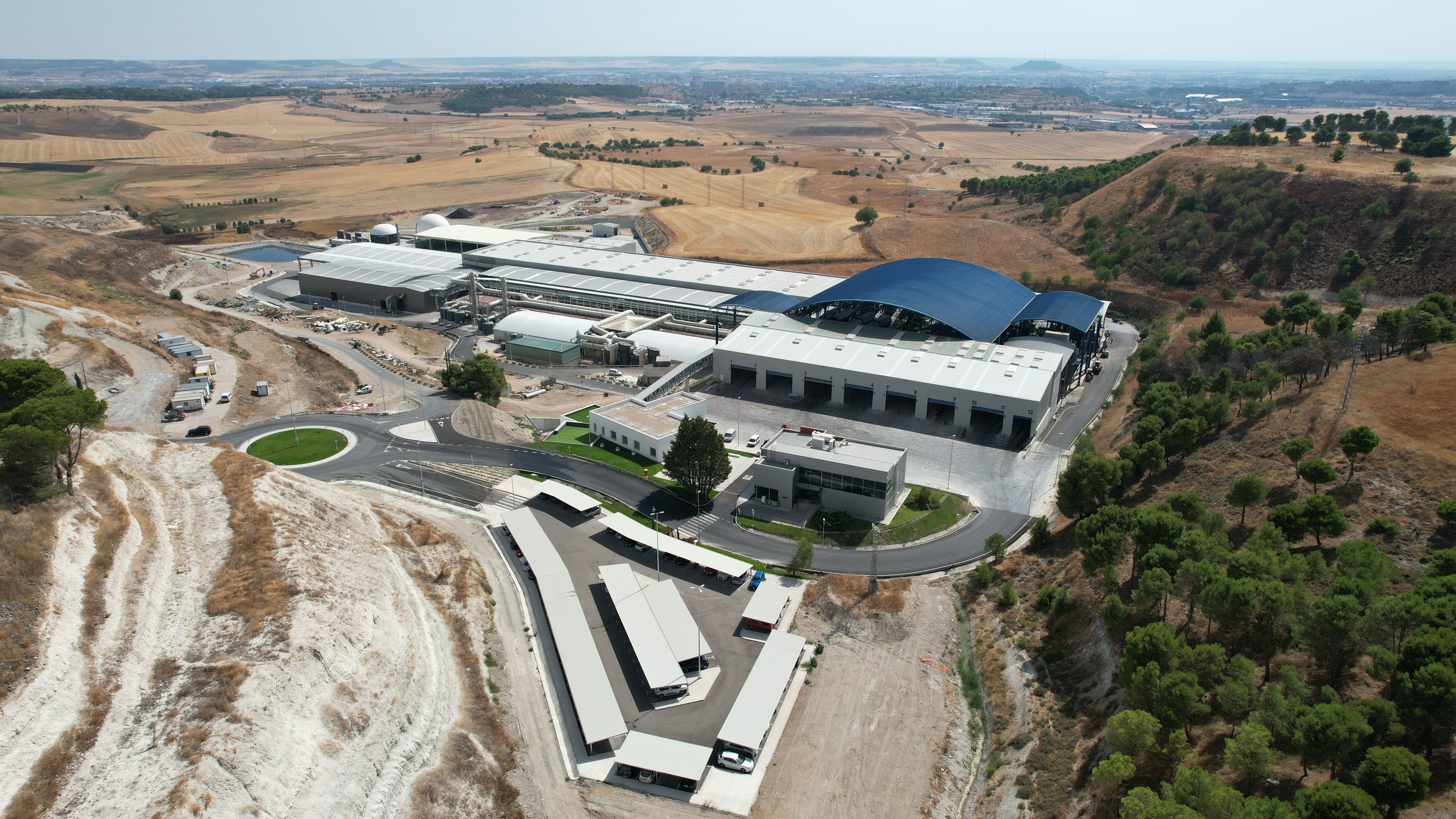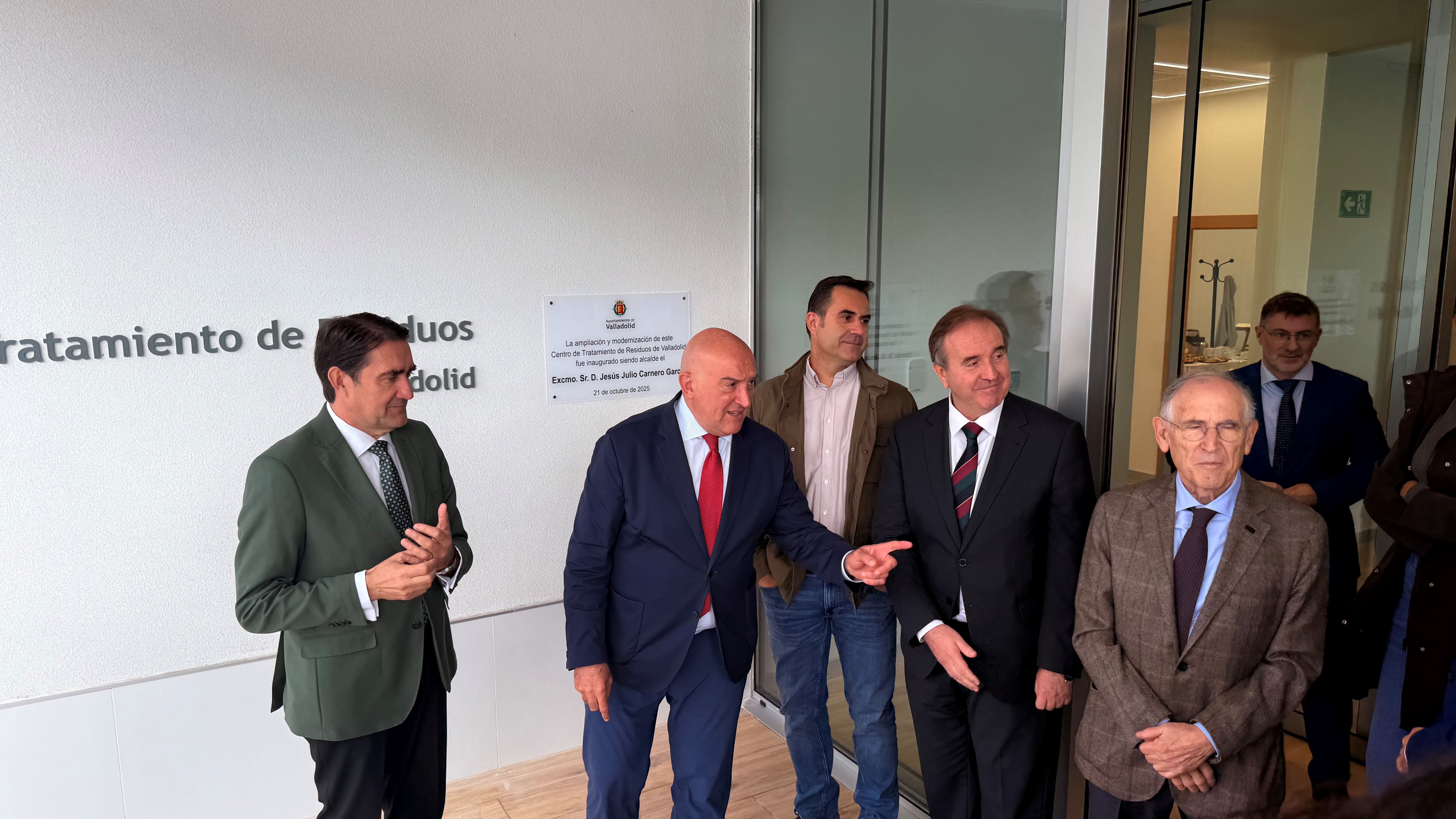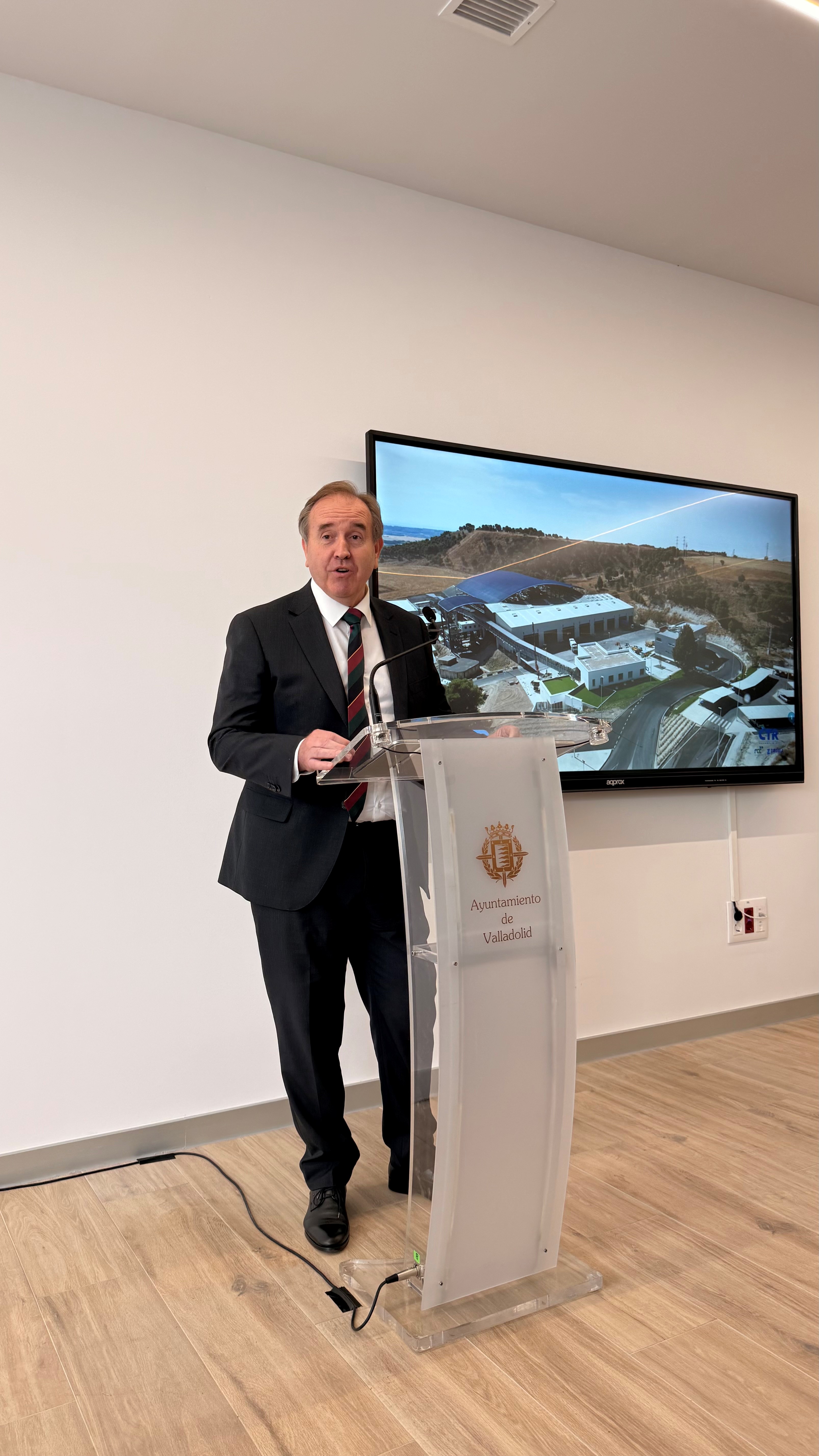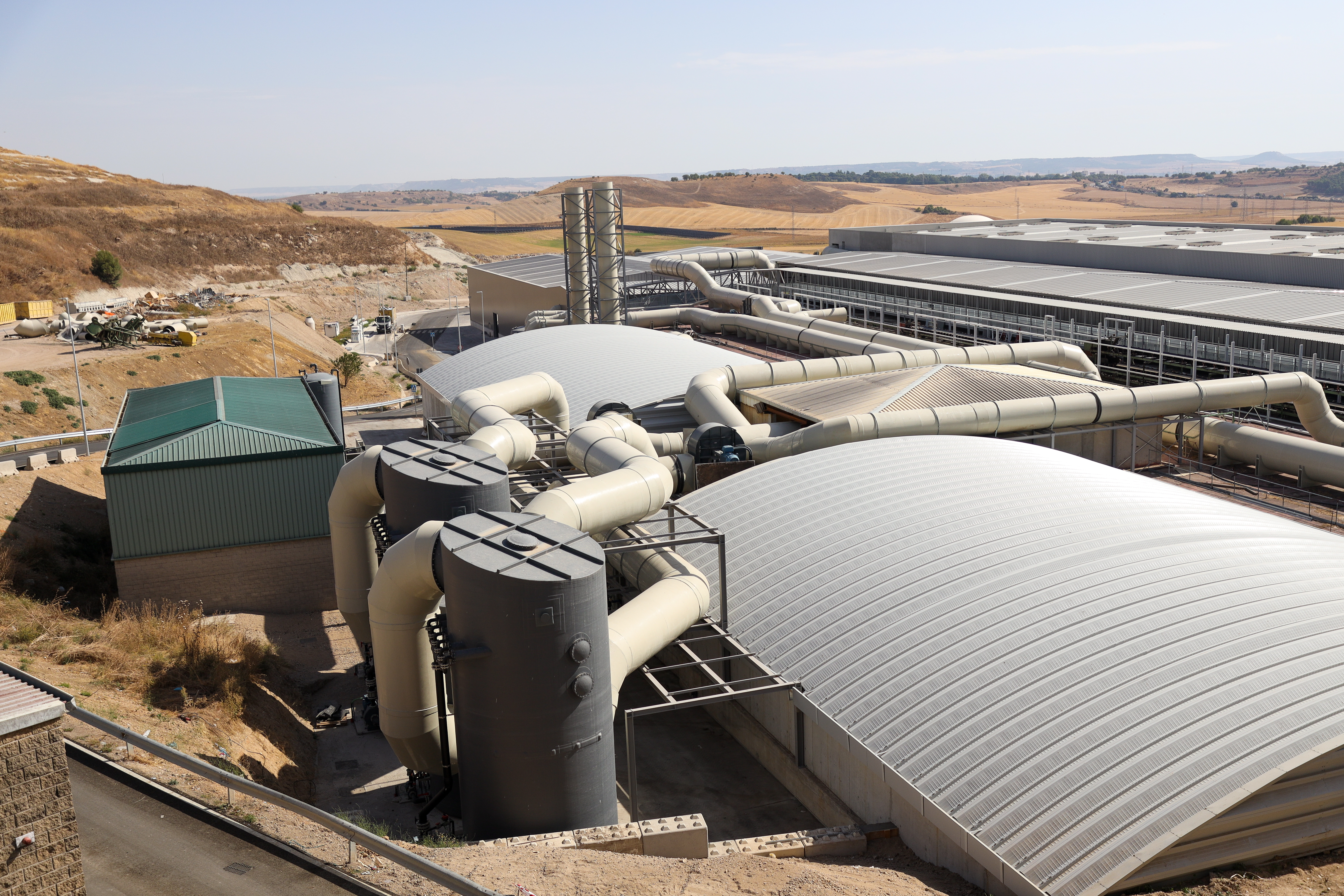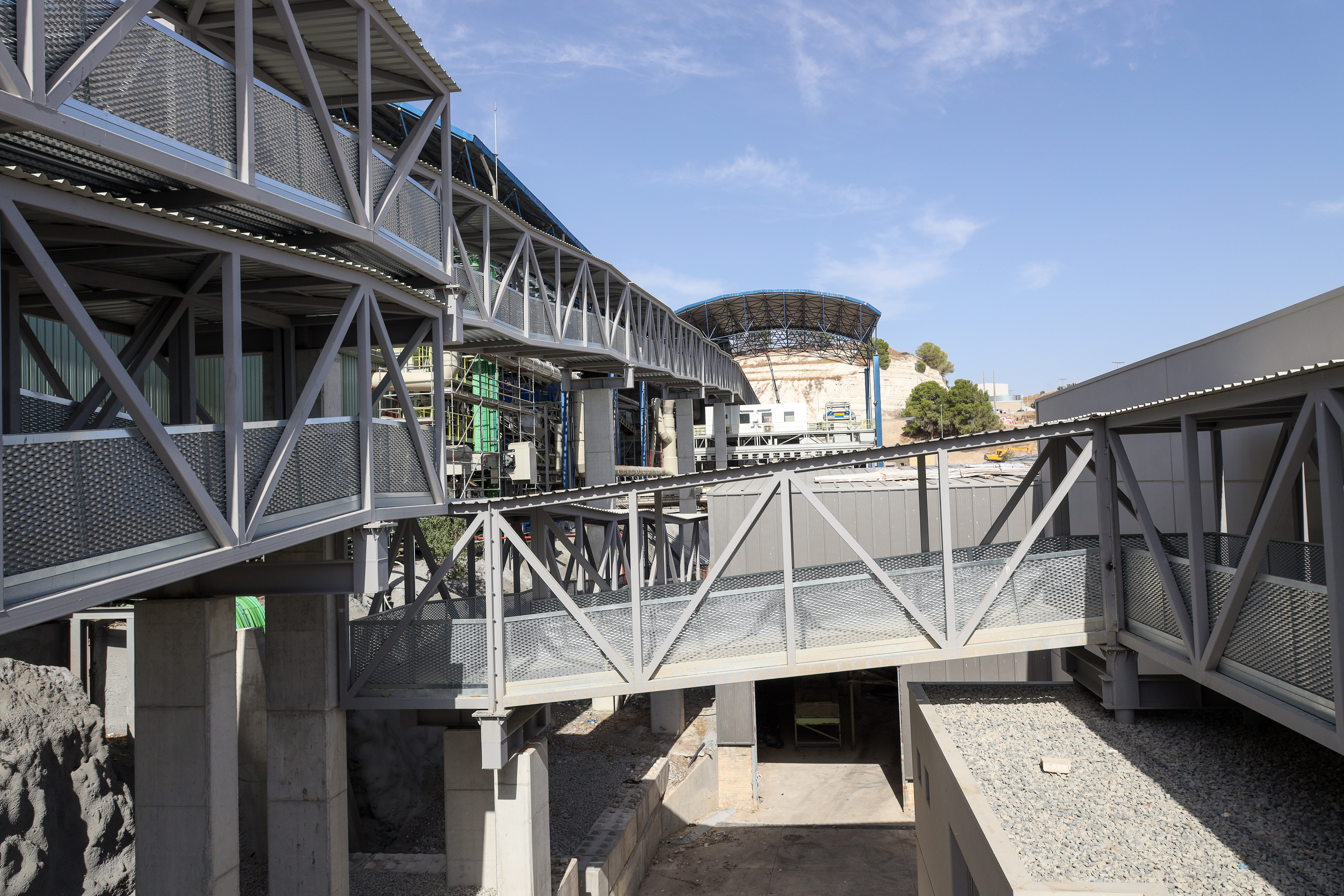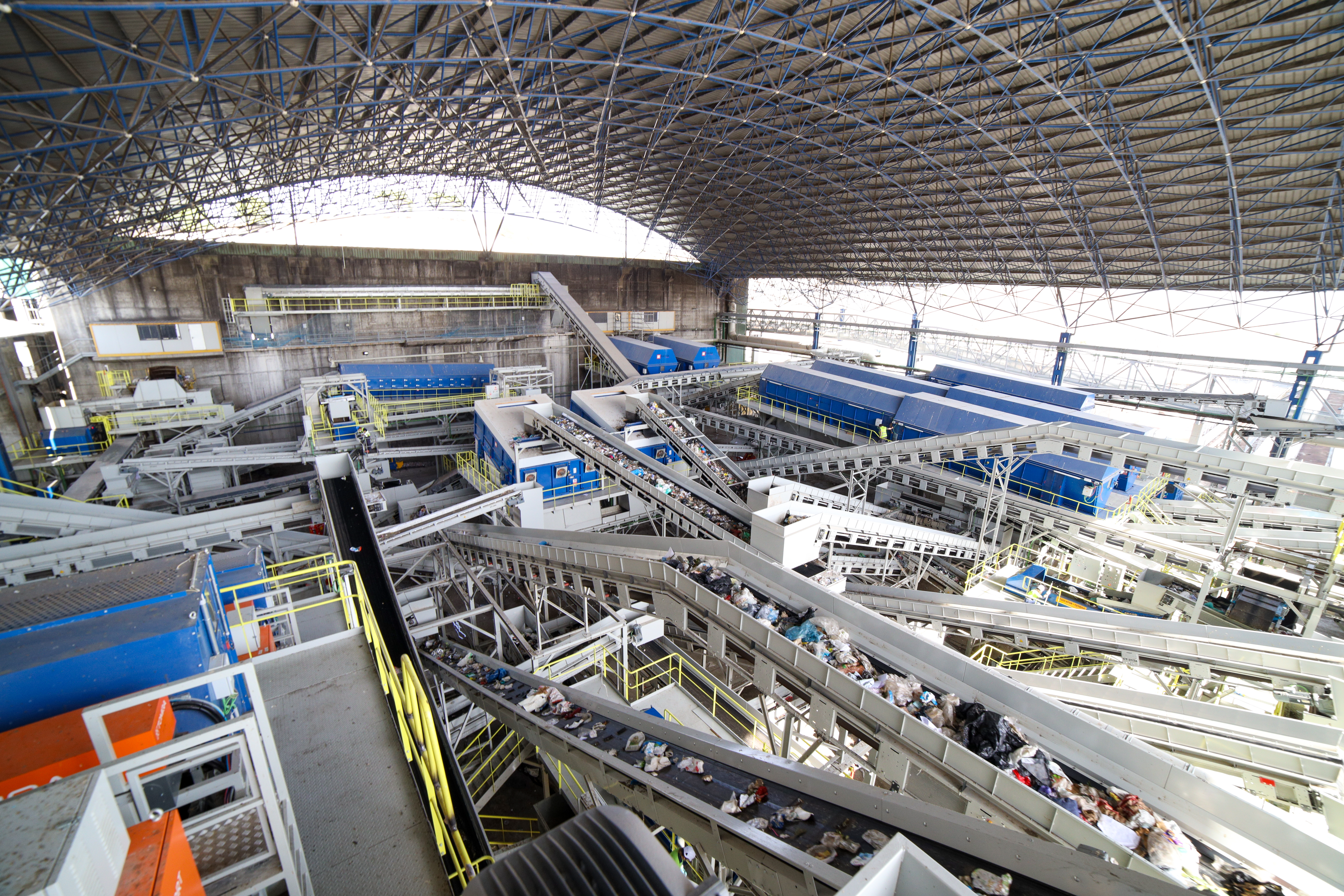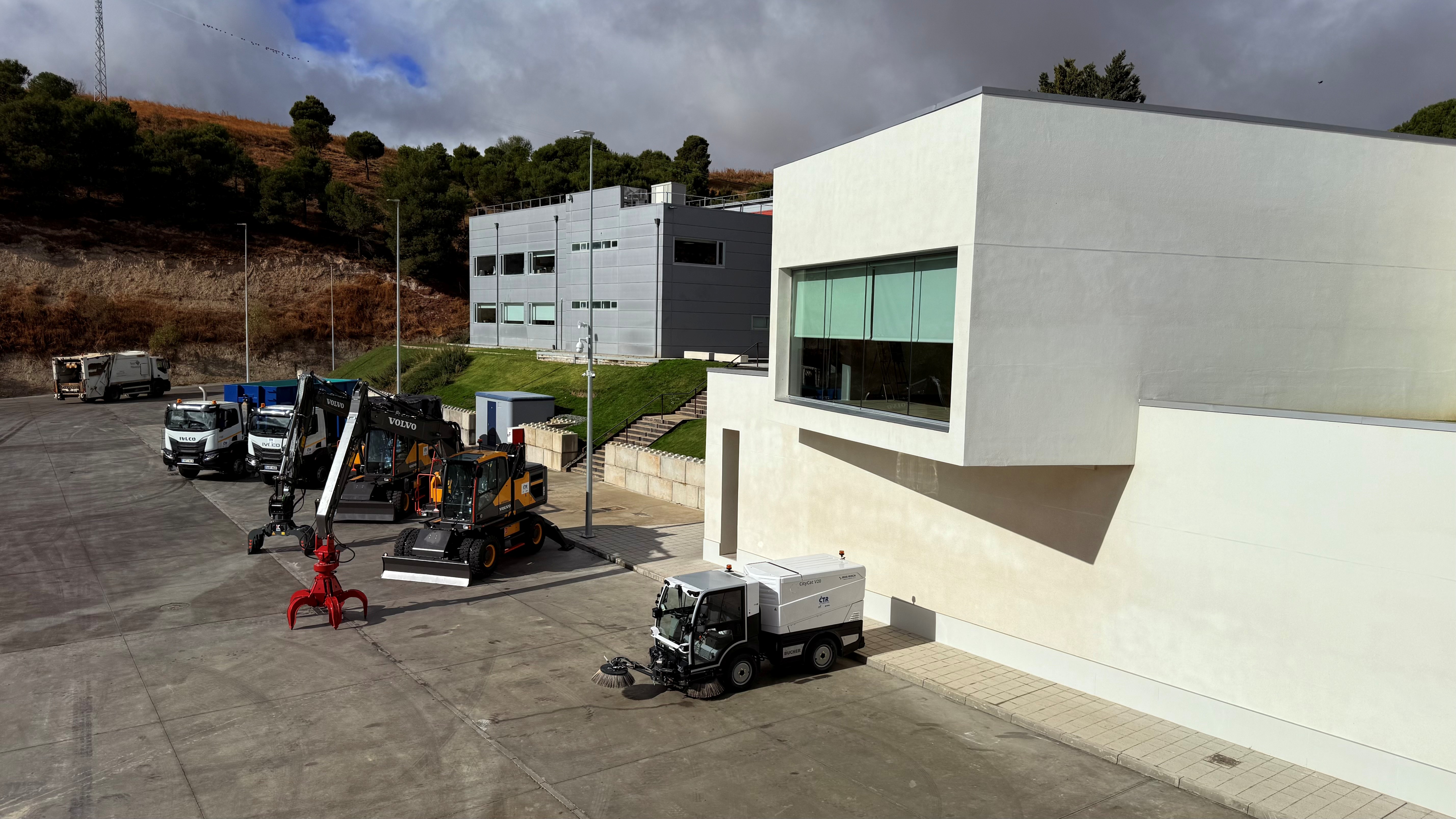The new Waste Treatment Centre in Valladolid is now fully operational
- The inauguration for the enlargement took place on October 21st and was attended by various authorities.
- The enlargement involves a complete refurbishment of the complex, which opened in 2002.
- With a total investment of €43 million, the project was carried out by the CTR Valladolid Joint Venture, led by FCC Medio Ambiente, which will also be running the service for a 9-year operating period.

The enlargement of the new Valladolid Waste Treatment Centre (WTC), which has a design capacity of 212,500 tonnes per year and serves 521,000 inhabitants all over the province, is now fully operational, reinforcing its commitment to sustainability, technological innovation and occupational well-being. The inauguration of the enlargement took place on October 21st, a complete refurbishment of the complex opened in 2002 that consolidates the city's circular economy model.
The inauguration was attended by Juan Carlos Suárez-Quiñones, Regional Minister for the Environment, Housing and Land Planning for Castilla y León; Jesús Julio Carnero, Mayor of the city; Alejandro García, Councillor of Environment at Valladolid City Council; and Javier Irigoyen, CEO of FCC Medio Ambiente. Carnero, Mayor of Valladolid, presided over the ceremony and highlighted that the facility “incorporates cutting-edge technology to increase material recovery, reduce landfill waste, stabilise organic flows and guarantee the Centre's full electricity self-consumption thanks to biogas”.
With a total investment of €43 million, the project has been executed and will be run for a 9-year operating period by the CTR Valladolid Joint Venture, led by FCC Medio Ambiente together with Construcciones y Contratas Zarzuela. With this enlargement, the WTC has not only increased its treatment capacity but has also redefined its operating model to become a European benchmark in efficiency, automation and sustainability. The new plant is thus consolidated as an essential element in achieving the recycling and recovery targets set by the European Union and advancing the transition towards a real and measurable circular economy.
It should be noted that the enlargement includes a new Research and Development (R&D) Centre for waste, designed as a platform for testing innovative technologies and collaborating with universities, technology centres and companies in the sector. This space will promote projects already under development: VALOMASK, ECLOSION, Zero Landfilling and CircBio 07, focused on waste recovery, applied biotechnology and energy efficiency.
In addition, the comprehensive use of biogas is one of the pillars of the new model. The expected production, around 9.16 million Nm³ per year, will cover 100% of the centre's own electricity consumption, reducing its carbon footprint and energy costs.
The new building for WTC staff represents a substantial improvement in working conditions and the quality of the working environment. Organised into spacious, bright and functional areas, it includes separate changing rooms covering more than 100 m², a 122 m² dining room and a 102 m² multi-purpose break room, all opening onto a large interior courtyard. This courtyard, designed as a place for rest and socialising, brings natural light and ventilation into the heart of the building, enhancing the well-being and improving the working conditions of the centre's operators.
You can take an aerial tour of the new Environmental Compound by watching this video here.
The new Waste Treatment Centre in Valladolid is now fully operational
- The inauguration for the enlargement took place on October 21st and was attended by various authorities.
- The enlargement involves a complete refurbishment of the complex, which opened in 2002.
- With a total investment of €43 million, the project was carried out by the CTR Valladolid Joint Venture, led by FCC Medio Ambiente, which will also be running the service for a 9-year operating period.

The enlargement of the new Valladolid Waste Treatment Centre (WTC), which has a design capacity of 212,500 tonnes per year and serves 521,000 inhabitants all over the province, is now fully operational, reinforcing its commitment to sustainability, technological innovation and occupational well-being. The inauguration of the enlargement took place on October 21st, a complete refurbishment of the complex opened in 2002 that consolidates the city's circular economy model.
The inauguration was attended by Juan Carlos Suárez-Quiñones, Regional Minister for the Environment, Housing and Land Planning for Castilla y León; Jesús Julio Carnero, Mayor of the city; Alejandro García, Councillor of Environment at Valladolid City Council; and Javier Irigoyen, CEO of FCC Medio Ambiente. Carnero, Mayor of Valladolid, presided over the ceremony and highlighted that the facility “incorporates cutting-edge technology to increase material recovery, reduce landfill waste, stabilise organic flows and guarantee the Centre's full electricity self-consumption thanks to biogas”.
With a total investment of €43 million, the project has been executed and will be run for a 9-year operating period by the CTR Valladolid Joint Venture, led by FCC Medio Ambiente together with Construcciones y Contratas Zarzuela. With this enlargement, the WTC has not only increased its treatment capacity but has also redefined its operating model to become a European benchmark in efficiency, automation and sustainability. The new plant is thus consolidated as an essential element in achieving the recycling and recovery targets set by the European Union and advancing the transition towards a real and measurable circular economy.
It should be noted that the enlargement includes a new Research and Development (R&D) Centre for waste, designed as a platform for testing innovative technologies and collaborating with universities, technology centres and companies in the sector. This space will promote projects already under development: VALOMASK, ECLOSION, Zero Landfilling and CircBio 07, focused on waste recovery, applied biotechnology and energy efficiency.
In addition, the comprehensive use of biogas is one of the pillars of the new model. The expected production, around 9.16 million Nm³ per year, will cover 100% of the centre's own electricity consumption, reducing its carbon footprint and energy costs.
The new building for WTC staff represents a substantial improvement in working conditions and the quality of the working environment. Organised into spacious, bright and functional areas, it includes separate changing rooms covering more than 100 m², a 122 m² dining room and a 102 m² multi-purpose break room, all opening onto a large interior courtyard. This courtyard, designed as a place for rest and socialising, brings natural light and ventilation into the heart of the building, enhancing the well-being and improving the working conditions of the centre's operators.
You can take an aerial tour of the new Environmental Compound by watching this video here.
The new Waste Treatment Centre in Valladolid is now fully operational
- The inauguration for the enlargement took place on October 21st and was attended by various authorities.
- The enlargement involves a complete refurbishment of the complex, which opened in 2002.
- With a total investment of €43 million, the project was carried out by the CTR Valladolid Joint Venture, led by FCC Medio Ambiente, which will also be running the service for a 9-year operating period.

The enlargement of the new Valladolid Waste Treatment Centre (WTC), which has a design capacity of 212,500 tonnes per year and serves 521,000 inhabitants all over the province, is now fully operational, reinforcing its commitment to sustainability, technological innovation and occupational well-being. The inauguration of the enlargement took place on October 21st, a complete refurbishment of the complex opened in 2002 that consolidates the city's circular economy model.
The inauguration was attended by Juan Carlos Suárez-Quiñones, Regional Minister for the Environment, Housing and Land Planning for Castilla y León; Jesús Julio Carnero, Mayor of the city; Alejandro García, Councillor of Environment at Valladolid City Council; and Javier Irigoyen, CEO of FCC Medio Ambiente. Carnero, Mayor of Valladolid, presided over the ceremony and highlighted that the facility “incorporates cutting-edge technology to increase material recovery, reduce landfill waste, stabilise organic flows and guarantee the Centre's full electricity self-consumption thanks to biogas”.
With a total investment of €43 million, the project has been executed and will be run for a 9-year operating period by the CTR Valladolid Joint Venture, led by FCC Medio Ambiente together with Construcciones y Contratas Zarzuela. With this enlargement, the WTC has not only increased its treatment capacity but has also redefined its operating model to become a European benchmark in efficiency, automation and sustainability. The new plant is thus consolidated as an essential element in achieving the recycling and recovery targets set by the European Union and advancing the transition towards a real and measurable circular economy.
It should be noted that the enlargement includes a new Research and Development (R&D) Centre for waste, designed as a platform for testing innovative technologies and collaborating with universities, technology centres and companies in the sector. This space will promote projects already under development: VALOMASK, ECLOSION, Zero Landfilling and CircBio 07, focused on waste recovery, applied biotechnology and energy efficiency.
In addition, the comprehensive use of biogas is one of the pillars of the new model. The expected production, around 9.16 million Nm³ per year, will cover 100% of the centre's own electricity consumption, reducing its carbon footprint and energy costs.
The new building for WTC staff represents a substantial improvement in working conditions and the quality of the working environment. Organised into spacious, bright and functional areas, it includes separate changing rooms covering more than 100 m², a 122 m² dining room and a 102 m² multi-purpose break room, all opening onto a large interior courtyard. This courtyard, designed as a place for rest and socialising, brings natural light and ventilation into the heart of the building, enhancing the well-being and improving the working conditions of the centre's operators.
You can take an aerial tour of the new Environmental Compound by watching this video here.
The new Waste Treatment Centre in Valladolid is now fully operational
- The inauguration for the enlargement took place on October 21st and was attended by various authorities.
- The enlargement involves a complete refurbishment of the complex, which opened in 2002.
- With a total investment of €43 million, the project was carried out by the CTR Valladolid Joint Venture, led by FCC Medio Ambiente, which will also be running the service for a 9-year operating period.

The enlargement of the new Valladolid Waste Treatment Centre (WTC), which has a design capacity of 212,500 tonnes per year and serves 521,000 inhabitants all over the province, is now fully operational, reinforcing its commitment to sustainability, technological innovation and occupational well-being. The inauguration of the enlargement took place on October 21st, a complete refurbishment of the complex opened in 2002 that consolidates the city's circular economy model.
The inauguration was attended by Juan Carlos Suárez-Quiñones, Regional Minister for the Environment, Housing and Land Planning for Castilla y León; Jesús Julio Carnero, Mayor of the city; Alejandro García, Councillor of Environment at Valladolid City Council; and Javier Irigoyen, CEO of FCC Medio Ambiente. Carnero, Mayor of Valladolid, presided over the ceremony and highlighted that the facility “incorporates cutting-edge technology to increase material recovery, reduce landfill waste, stabilise organic flows and guarantee the Centre's full electricity self-consumption thanks to biogas”.
With a total investment of €43 million, the project has been executed and will be run for a 9-year operating period by the CTR Valladolid Joint Venture, led by FCC Medio Ambiente together with Construcciones y Contratas Zarzuela. With this enlargement, the WTC has not only increased its treatment capacity but has also redefined its operating model to become a European benchmark in efficiency, automation and sustainability. The new plant is thus consolidated as an essential element in achieving the recycling and recovery targets set by the European Union and advancing the transition towards a real and measurable circular economy.
It should be noted that the enlargement includes a new Research and Development (R&D) Centre for waste, designed as a platform for testing innovative technologies and collaborating with universities, technology centres and companies in the sector. This space will promote projects already under development: VALOMASK, ECLOSION, Zero Landfilling and CircBio 07, focused on waste recovery, applied biotechnology and energy efficiency.
In addition, the comprehensive use of biogas is one of the pillars of the new model. The expected production, around 9.16 million Nm³ per year, will cover 100% of the centre's own electricity consumption, reducing its carbon footprint and energy costs.
The new building for WTC staff represents a substantial improvement in working conditions and the quality of the working environment. Organised into spacious, bright and functional areas, it includes separate changing rooms covering more than 100 m², a 122 m² dining room and a 102 m² multi-purpose break room, all opening onto a large interior courtyard. This courtyard, designed as a place for rest and socialising, brings natural light and ventilation into the heart of the building, enhancing the well-being and improving the working conditions of the centre's operators.
You can take an aerial tour of the new Environmental Compound by watching this video here.
The new Waste Treatment Centre in Valladolid is now fully operational
- The inauguration for the enlargement took place on October 21st and was attended by various authorities.
- The enlargement involves a complete refurbishment of the complex, which opened in 2002.
- With a total investment of €43 million, the project was carried out by the CTR Valladolid Joint Venture, led by FCC Medio Ambiente, which will also be running the service for a 9-year operating period.

The enlargement of the new Valladolid Waste Treatment Centre (WTC), which has a design capacity of 212,500 tonnes per year and serves 521,000 inhabitants all over the province, is now fully operational, reinforcing its commitment to sustainability, technological innovation and occupational well-being. The inauguration of the enlargement took place on October 21st, a complete refurbishment of the complex opened in 2002 that consolidates the city's circular economy model.
The inauguration was attended by Juan Carlos Suárez-Quiñones, Regional Minister for the Environment, Housing and Land Planning for Castilla y León; Jesús Julio Carnero, Mayor of the city; Alejandro García, Councillor of Environment at Valladolid City Council; and Javier Irigoyen, CEO of FCC Medio Ambiente. Carnero, Mayor of Valladolid, presided over the ceremony and highlighted that the facility “incorporates cutting-edge technology to increase material recovery, reduce landfill waste, stabilise organic flows and guarantee the Centre's full electricity self-consumption thanks to biogas”.
With a total investment of €43 million, the project has been executed and will be run for a 9-year operating period by the CTR Valladolid Joint Venture, led by FCC Medio Ambiente together with Construcciones y Contratas Zarzuela. With this enlargement, the WTC has not only increased its treatment capacity but has also redefined its operating model to become a European benchmark in efficiency, automation and sustainability. The new plant is thus consolidated as an essential element in achieving the recycling and recovery targets set by the European Union and advancing the transition towards a real and measurable circular economy.
It should be noted that the enlargement includes a new Research and Development (R&D) Centre for waste, designed as a platform for testing innovative technologies and collaborating with universities, technology centres and companies in the sector. This space will promote projects already under development: VALOMASK, ECLOSION, Zero Landfilling and CircBio 07, focused on waste recovery, applied biotechnology and energy efficiency.
In addition, the comprehensive use of biogas is one of the pillars of the new model. The expected production, around 9.16 million Nm³ per year, will cover 100% of the centre's own electricity consumption, reducing its carbon footprint and energy costs.
The new building for WTC staff represents a substantial improvement in working conditions and the quality of the working environment. Organised into spacious, bright and functional areas, it includes separate changing rooms covering more than 100 m², a 122 m² dining room and a 102 m² multi-purpose break room, all opening onto a large interior courtyard. This courtyard, designed as a place for rest and socialising, brings natural light and ventilation into the heart of the building, enhancing the well-being and improving the working conditions of the centre's operators.
You can take an aerial tour of the new Environmental Compound by watching this video here.
The new Waste Treatment Centre in Valladolid is now fully operational
- The inauguration for the enlargement took place on October 21st and was attended by various authorities.
- The enlargement involves a complete refurbishment of the complex, which opened in 2002.
- With a total investment of €43 million, the project was carried out by the CTR Valladolid Joint Venture, led by FCC Medio Ambiente, which will also be running the service for a 9-year operating period.

The enlargement of the new Valladolid Waste Treatment Centre (WTC), which has a design capacity of 212,500 tonnes per year and serves 521,000 inhabitants all over the province, is now fully operational, reinforcing its commitment to sustainability, technological innovation and occupational well-being. The inauguration of the enlargement took place on October 21st, a complete refurbishment of the complex opened in 2002 that consolidates the city's circular economy model.
The inauguration was attended by Juan Carlos Suárez-Quiñones, Regional Minister for the Environment, Housing and Land Planning for Castilla y León; Jesús Julio Carnero, Mayor of the city; Alejandro García, Councillor of Environment at Valladolid City Council; and Javier Irigoyen, CEO of FCC Medio Ambiente. Carnero, Mayor of Valladolid, presided over the ceremony and highlighted that the facility “incorporates cutting-edge technology to increase material recovery, reduce landfill waste, stabilise organic flows and guarantee the Centre's full electricity self-consumption thanks to biogas”.
With a total investment of €43 million, the project has been executed and will be run for a 9-year operating period by the CTR Valladolid Joint Venture, led by FCC Medio Ambiente together with Construcciones y Contratas Zarzuela. With this enlargement, the WTC has not only increased its treatment capacity but has also redefined its operating model to become a European benchmark in efficiency, automation and sustainability. The new plant is thus consolidated as an essential element in achieving the recycling and recovery targets set by the European Union and advancing the transition towards a real and measurable circular economy.
It should be noted that the enlargement includes a new Research and Development (R&D) Centre for waste, designed as a platform for testing innovative technologies and collaborating with universities, technology centres and companies in the sector. This space will promote projects already under development: VALOMASK, ECLOSION, Zero Landfilling and CircBio 07, focused on waste recovery, applied biotechnology and energy efficiency.
In addition, the comprehensive use of biogas is one of the pillars of the new model. The expected production, around 9.16 million Nm³ per year, will cover 100% of the centre's own electricity consumption, reducing its carbon footprint and energy costs.
The new building for WTC staff represents a substantial improvement in working conditions and the quality of the working environment. Organised into spacious, bright and functional areas, it includes separate changing rooms covering more than 100 m², a 122 m² dining room and a 102 m² multi-purpose break room, all opening onto a large interior courtyard. This courtyard, designed as a place for rest and socialising, brings natural light and ventilation into the heart of the building, enhancing the well-being and improving the working conditions of the centre's operators.
You can take an aerial tour of the new Environmental Compound by watching this video here.
The new Waste Treatment Centre in Valladolid is now fully operational
- The inauguration for the enlargement took place on October 21st and was attended by various authorities.
- The enlargement involves a complete refurbishment of the complex, which opened in 2002.
- With a total investment of €43 million, the project was carried out by the CTR Valladolid Joint Venture, led by FCC Medio Ambiente, which will also be running the service for a 9-year operating period.

The enlargement of the new Valladolid Waste Treatment Centre (WTC), which has a design capacity of 212,500 tonnes per year and serves 521,000 inhabitants all over the province, is now fully operational, reinforcing its commitment to sustainability, technological innovation and occupational well-being. The inauguration of the enlargement took place on October 21st, a complete refurbishment of the complex opened in 2002 that consolidates the city's circular economy model.
The inauguration was attended by Juan Carlos Suárez-Quiñones, Regional Minister for the Environment, Housing and Land Planning for Castilla y León; Jesús Julio Carnero, Mayor of the city; Alejandro García, Councillor of Environment at Valladolid City Council; and Javier Irigoyen, CEO of FCC Medio Ambiente. Carnero, Mayor of Valladolid, presided over the ceremony and highlighted that the facility “incorporates cutting-edge technology to increase material recovery, reduce landfill waste, stabilise organic flows and guarantee the Centre's full electricity self-consumption thanks to biogas”.
With a total investment of €43 million, the project has been executed and will be run for a 9-year operating period by the CTR Valladolid Joint Venture, led by FCC Medio Ambiente together with Construcciones y Contratas Zarzuela. With this enlargement, the WTC has not only increased its treatment capacity but has also redefined its operating model to become a European benchmark in efficiency, automation and sustainability. The new plant is thus consolidated as an essential element in achieving the recycling and recovery targets set by the European Union and advancing the transition towards a real and measurable circular economy.
It should be noted that the enlargement includes a new Research and Development (R&D) Centre for waste, designed as a platform for testing innovative technologies and collaborating with universities, technology centres and companies in the sector. This space will promote projects already under development: VALOMASK, ECLOSION, Zero Landfilling and CircBio 07, focused on waste recovery, applied biotechnology and energy efficiency.
In addition, the comprehensive use of biogas is one of the pillars of the new model. The expected production, around 9.16 million Nm³ per year, will cover 100% of the centre's own electricity consumption, reducing its carbon footprint and energy costs.
The new building for WTC staff represents a substantial improvement in working conditions and the quality of the working environment. Organised into spacious, bright and functional areas, it includes separate changing rooms covering more than 100 m², a 122 m² dining room and a 102 m² multi-purpose break room, all opening onto a large interior courtyard. This courtyard, designed as a place for rest and socialising, brings natural light and ventilation into the heart of the building, enhancing the well-being and improving the working conditions of the centre's operators.
You can take an aerial tour of the new Environmental Compound by watching this video here.
Presentacion Corporativa FCC enviro 2025.pdf
Version 1.1 Approved- Document Type
- Basic Document
- Extension
- Size
- 21.9 MB
- Modified
- 10/30/25 8:06 AM by BELEN CASTILLO VELASCO
- Created
- 10/30/25 8:06 AM by BELEN CASTILLO VELASCO
- Location
- ENVIRO
-
Version 1.1By BELEN CASTILLO VELASCO, on 10/30/25 8:06 AMNo Change Log
-
Version 1.0By BELEN CASTILLO VELASCO, on 10/30/25 8:04 AMNo Change Log
Quality Management
 FCC Medio Ambiente Quality Management System complies with the UNE-EN ISO 9001:2015 international standard and has been audited by AENOR, certified under ER-0278/1997 in 1997.
FCC Medio Ambiente Quality Management System complies with the UNE-EN ISO 9001:2015 international standard and has been audited by AENOR, certified under ER-0278/1997 in 1997.
The main requirements of this international standard include the development of documented management policies and procedures for the correct operational development of the organisation, the analysis and review of the needs and expectations of stakeholders to achieve the expected quality levels, the determination of legal or other requirements that may affect the organisation in relation to its control and compliance, and the monitoring, measurement, analysis and improvement of the management system. It is for this reason that FCC's Management System is based on the PDCA methodology (Plan-Do-Check and Act), the principle of continuously improving the activities it develops and which require ensuring the effective and excellent provision of services to our customers, also based on citizen satisfaction.

Mixed washing system at the Third Millennium Bridge (Zaragoza)






